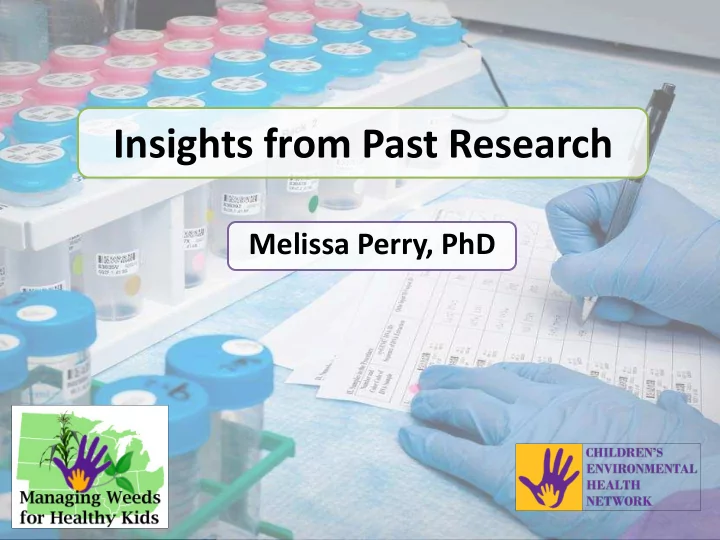

Insights from Past Research Melissa Perry, PhD
Knowledge Base • Nearly two dozen papers from rural birth center studies in the 1990s • Several epidemiological studies on atrazine and 2,4-D • Limited but growing biomonitoring data • Results of multiple Agricultural Health Study projects • Numerous published animal studies assessing impacts on reproduction and development
Biomonitoring Confirms Widespread Herbicide Exposures Glyphosate and AMPA (primary glyphosate metabolite) residues in human urine have been rising in the U.S. population since around 2005, and have increased about a 4-fold in many people. In 2009-2010, CDC sampled the urine of 2,747 people…
CDC Study Results • Geometric mean of urinary 2,4-D levels was 0.308 µg/l (microgram per liter, or ppb) (CDC, 2015) • U.C. San Francisco team found glyphosate residues in the urine of 93% of study participants • Detailed results for glyphosate residues as reported by (Adams et al., 2016): Glyphosate Residue Type Number of Samples (µg/l) Women 75 2.9 Men 56 3.3 Children 7 3.6
Birth Center Study Results Glyphosate, 2,4-D, and dicamba were among the herbicides identified as increasing the risk of adverse reproductive outcomes
Key Insight Greatest risk of herbicide- induced reproductive problems and birth defects occurs when the period from one month prior to conception through the first trimester of pregnancy coincides with the herbicide spraying season. References: (Arbuckle et al., 2001; Chevrier et al., 2011; Garry et al., 1996, 2002; Rappazzo et al., 2016; Schreinemachers, 2003, 2010; Winchester et al., 2016)
So, what is the spray season in the Midwest? • Historically, heavy herbicide spray season lasted 6 weeks to 2 months • New GE herbicide-resistant crops will extend the spray season to at least 4 months • Mid to late summer applications will lead to new routes of exposure via food, drinking water, and the air
Key Study: Pesticide Applicators and Farm Families in the Minnesota’s Red River Valley (Garry et al., 1996, and 2002) • Highest odds ratio across all associations for glyphosate and neurobehavioral disorders (ADHD; OR=3.6) • Glyphosate applied by one or both parents of 6 children with ADD/ADHD, out of a total 14 • Study took place before widespread planting of GE-HR crops
Other Key Insights from Garry et al., 2002 • Only 63% of birth defects diagnosed in first year of an infant’s life • 26% diagnosed at age 3 or later • Need to track children for several years to fully capture adverse birth outcomes
Recommend
More recommend